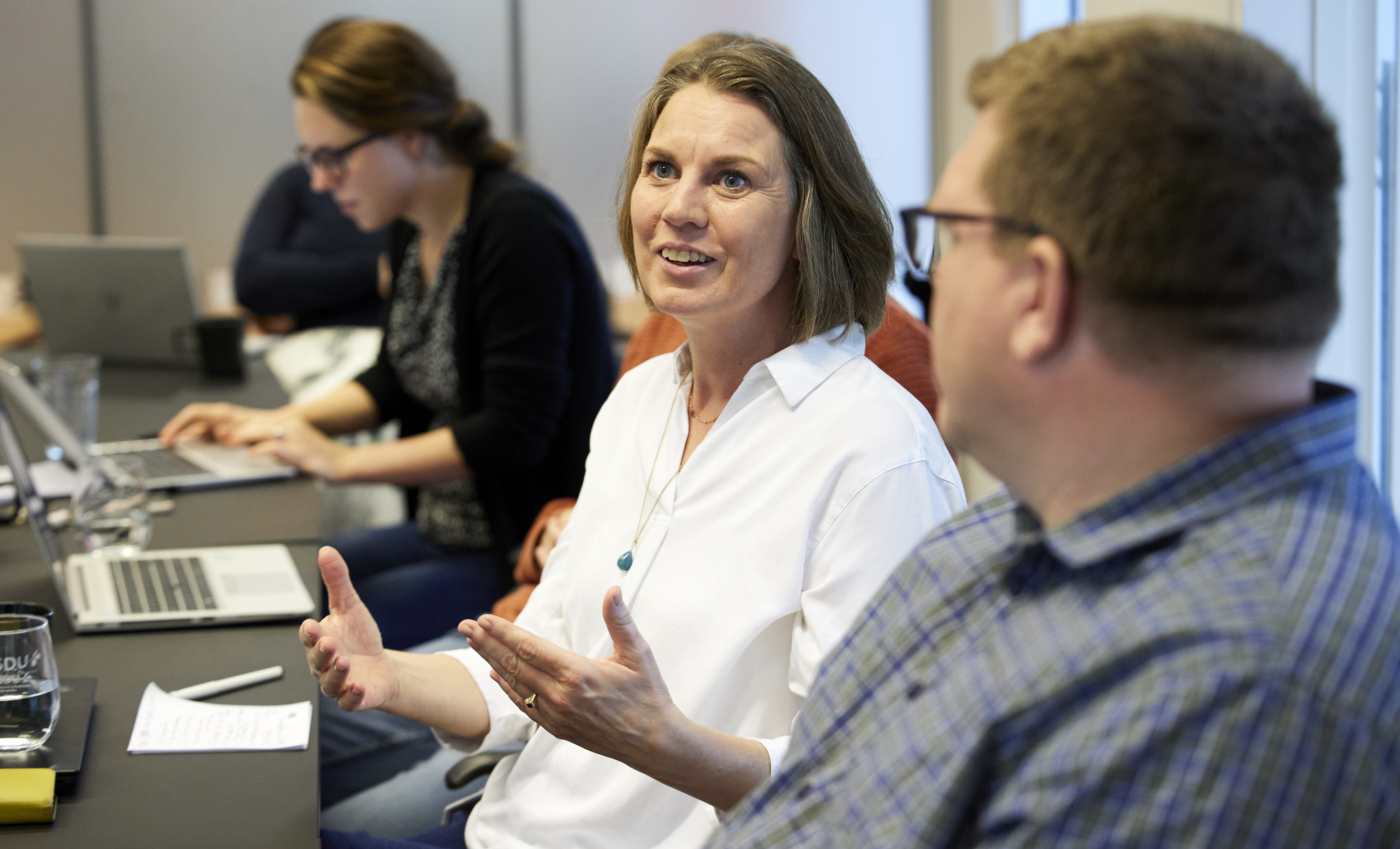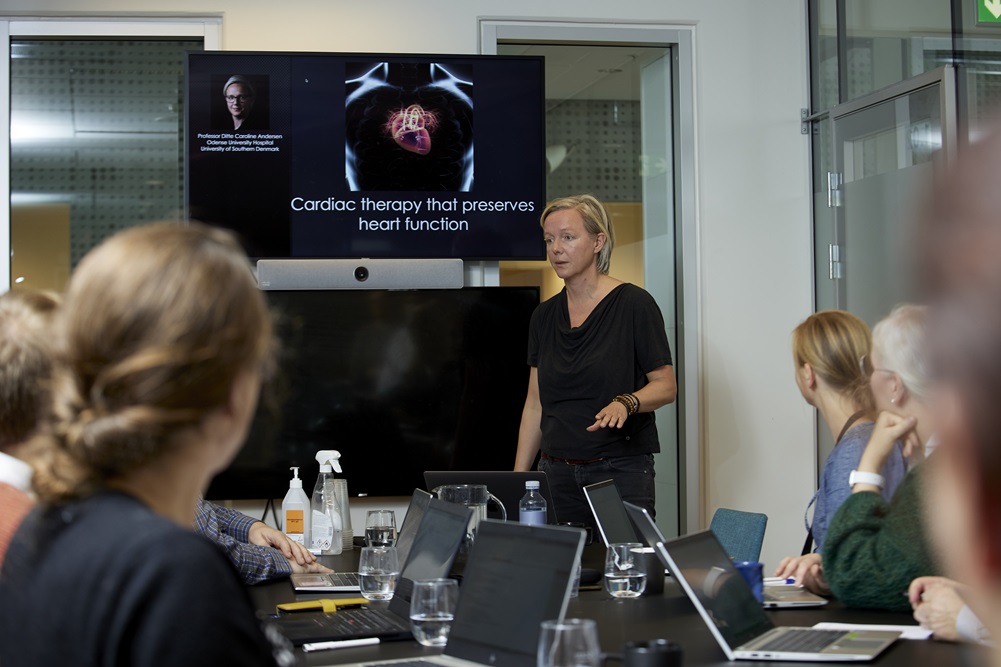Commercialise your Innovative Idea
Commercialising innovative ideas is crucial for researchers to make a societal impact. Our dedicated team is here to help ensuring accessibility and scalability of transformative technologies. Together, we bridge academia and industry, fostering progress and enhancing lives. Let us support you in your commercialisation journey.
How does Commercialisation work?
SDU is committed to transforming innovative ideas into societal impact through commercialisation of its research.
The Commercialisation Team helps researchers identify and protect innovative ideas that have commercial potential. The team also helps secure funding to further develop the innovative idea or technology.
The Commercialisation Team has a large network of industry partners, entrepreneurs and investors that provide valuable input to the development projects and engage actively in the projects when relevant.
The aim is to eventually negotiate a commercial deal allowing a company (spin-out or existing) to further develop and market a product or service based on the innovative idea.

Report your invention
Ready to talk with us? Describe your idea or discovery in the disclosure form and start the conversation.
What is the Commercialization Process at SDU?
FAQ
There are three basic criteria for patentability:
- Novelty: to be granted a patent, the invention must be the first of its kind in the world;
- Utility: a valid patent cannot be obtained for something that does not work or that has no useful function;
- Inventiveness: to be patentable, your invention must be a new development or an improvement of an existing technology that would not have been obvious to someone working in your area of specialty.
Patent applications are drafted by an external patent attorney. The TTO has access to specialists in almost any field. The patent attorney will involve you in the writing process and ask you to review the application before it is filed.

When you are employed at a public research institution, you have a duty to report any invention, that you have made in connection with your work. (jf. Lov om opfindelser ved offentlige forskningsinstitutioner). A patent grants the owner of the invention the right to exclude others from producing, using, selling or importing the invention into a geographical territory for a limited period - for up to 20 years.
.png?la=en&hash=34EEB925E0F0D915A213742107C0CA8F)
“Commercialisation of your research is a way to increase its societal impact through awareness, practical applicability and economic growth. That’s why SDU RIO has a dedicated Commercialisation team, ready to help you bring your innovative idea from the lab to industry or spin-out. We work to help you assess the potential of your idea, apply for innovation-based funding, explore IP protection and potentially license or spinout the new technology.”
Thomas Schmidt
Head of Commercialisation
Commercialization Support
There are several teams at SDU working to commercialize research. The teams are either based in the respective department or at SDU RIO. In the below you may find the team that can assist you.
Who to contact in the Commercialisation Team?
The Commercialization team at RIO supports researchers in bringing innovative ideas to the market. Our team gives advice and guidance with:
- Facilitating technology transfer and commercialization
- Support entrepreneurship and industry engagement
The Commercialization team at RIO supports researchers in bringing innovative ideas to the market. Our team gives advice and guidance with:
- Facilitating technology transfer and commercialization
- Support entrepreneurship and industry engagement
If you think you have made an invention or have any questions regarding IP protection, commercialisation of research results or spinning out a company, please contact one of our specialists below.
The Commercialization team at RIO supports researchers in bringing innovative ideas to the market. Our team gives advice and guidance with:
- Facilitating technology transfer and commercialization
- Support entrepreneurship and industry engagement
If you think you have made an invention or have any questions regarding IP protection, commercialisation of research results or spinning out a company, please contact one of our specialists below.
The Commercialization team at RIO supports researchers in bringing innovative ideas to the market. Our team gives advice and guidance with:
- Facilitating technology transfer and commercialization
- Support entrepreneurship and industry engagement
If you think you have made an invention or have any questions regarding IP protection, commercialisation of research results or spinning out a company, please contact one of our specialists below.
What type of support can I get?
IP protection
Intellectual property (IP) is or can be protected in different ways depending on the nature of the IP. We can help you assess what kind of protection is appropriate for your innovative idea. If you have an invention or product, it can be protected under a patent, trademark or utility model.
Info meetings and informal advice
Do you want to know how you can commercialise your invention? Or when patent protection is relevant to your work? We host information meetings to departments or teams about IP protection and the commercialisation process. We tailor our talks to your needs, from 20-minute overview or focus on a particular topic at a department meeting to longer sessions with time to dive into the details and examples that are relevant to you.
Network
We use our extensive network together with you find the right information, funding or collaboration partner. We invite entrepreneurs to join us in our office, and we attend partnering events such as Nordic Innovation Fair and BIO-Europe to find the right match for you and your innovative idea. In addition, we can point you and your research in the right direction in regard to meeting the right people for commercialising your idea.
Funding
We can help you identify and apply for innovation-directed funding that suits your project.
Market research
Market research plays a crucial role in the commercialisation process. Through this we evaluate the commercial potential, and it provides valuable insights into the existing market landscape, including potential competitors, target demographics, and market demand. Thereby we can assess the viability of your innovative idea, identify potential licensing or commercialization opportunities, and develop effective strategies for intellectual property protection and commercialization.
Legal agreements
We work closely with the Legal Team at SDU RIO whenever we need legal support for the commercialisation process. This can, for example, be in relation to confidentiality agreements or license agreements.
Marketing
We develop marketing materials and present you and your research results through a variety of channels to connect with companies or investors who have the expertise, resources and network to get your invention to the market. It can either involve a partnership with an existing company or the formation of a spin-out.
Impact in numbers and cases
At SDU RIO we work with researchers to commercialise their innovative ideas. In the below you can see recent figures and cases from the office.
Research Tools
New Technologies
See the list over new technologies that SDU is working on
11
New Patent Applications
28
Inventions Disclosed
2
Spinouts
-
![]()
TEK
BIOOMIX ApS- Spinout
In the future farmers and gardeners will use the soil's own bacteria for sustainable fertilizer. Researchers in Bioomix have developed a 3D-printed bacterial trap that collects soil bacteria from the field. They extract the good soil bacteria in the laboratory and develop them into nature's own fertilizer, which does not harm the environment and groundwater.
Visit Website -
![]()
TEK and SUND
EVIDO Health - Spinout
Evido is founded and anchored in state-of-the-art clinical research where the suffering from untimely diagnosis of chronic liver disease sparked the urge to do more. We want to help an enormous group of at-risk people that are not getting the support they deserve. A group that is unaware of the risk they are facing and the fatal implication if their disease continues to progress.
Visit Webpage
Spinouts from SDU
University spinouts are companies that are created on the back of academic research. Our spinouts turn university research into societal impact and in the following you can read about some of them.
Resources
Below you can find different type of resources such as pdf and forms for the commercialisation process.
Research Tools
New Technologies
See the list over new technologies that SDU is working on
Forms and Contracts
If you have made an invention, please use the form below to report it by sending it to inventions@sdu.dk.
If you don’t know if now is the time to report it, or have any other questions, please email inventions@sdu.dk – we’re happy to help.
For an in-depth information on how inventions are handled at SDU, what’s required from you and how the Commercialisation Team can help, please refer to the inventor’s guide.
The Inventor’s Guide outlines the essential elements of Technology Transfer at University of Southern Denmark (SDU) and the Hospitals of the Region of Southern Denmark (RSD). This guide is provided to answer the most common questions we typically receive from our research community and provides a broad overview of the technology transfer process and services available for researchers. The guide is separated into four parts that can be read separate or as one.
The Commercialization Team at University of Southern Denmark also supports inventors from Region of Southern Denmark including Odense University Hospital (OUH).
An MTA includes an agreement on the transfer of a physical material to be used in the research – such as biological material, cell lines, chemical substances or the like.
The purpose of the agreement is to clarify the conditions for the use of the material, as well as to create clarity regarding the rights and obligations of the parties.
Reach out to inventions@sdu.dk for help establishing an MTA.
Cooperation often involves exchanging confidential information. It is often the case that a business partner is required to conclude an agreement of confidentiality before negotiations regarding cooperation commence.
An NDA aims to ensure that confidential information can be freely exchanged between the two parties to the agreement - with the assurance however that the information will remain confidential and not be disclosed.
Reach out to inventions@sdu.dk for help establishing an NDA.
Some funds allow young researchers to explore research ideas that have commercial potential. This is especially valuable for researchers who want to start a business or create a product or service based on their research.
Commercialisation
Top innovation funds in Denmark
Find different opportunities for your research idea
InnoExplorer grant
InnoExplorer is Innovationsfonden's program that aims to mature entrepreneurship based on knowledge and research results from the public Danish research and education institutions and hospitals.
InnoExplorer is targeted at employees at public research and educational institutions and hospitals, that have achieved research results with commercial potential and aim to establish a business based on these results.
Please note that the next deadline is August 19th 2024. Please see internal application deadlines below.
Dates and deadlines in 2024
| First application round | |
| January 7th | Deadline for expression of interest sent to SDU RIO |
| January 9th | Latest approval notification from RIO to apply under the program |
| January 31th | Application deadline for InnoExplorer |
| March 6th | Latest date for completed training pitch |
| March | InnoExplorer panel (between March 11th and March 29th) |
| Second application round | |
| March 11th | Deadline for expression of interest sent to SDU RIO |
| April 2nd | Latest approval notification from RIO to apply under the program |
| April 24th | Application deadline for InnoExplorer |
| May 30th | Latest date for completed training pitch |
| June | InnoExplorer panel (between June 3rd and June 21st ) |
| Third application round | |
| August 19th | Deadline for expression of interest sent to SDU RIO |
| September 3rd | Latest approval notification from RIO to apply under the program |
| September 25th | Application deadline for InnoExplorer |
| October 31st | Latest date for completed training pitch |
| November | InnoExplorer panel (between November 4th and November 22th) |
At SDU there is local screening and selection before applying for the programme.
It is SDU's experience that a successful application generally requires a significant work effort in the months leading up to the deadline, and more skills are needed around the applicant to both find convincing data and train the presentation. It is SDU's experience from 10 application rounds in the period 2019-2021 that applications for the InnoExplorer program were not successful if:
- The application is rushed through shortly before the deadline
- Applicant has not practiced pitching in front of a commercially-oriented panel
- Applications are not able to convince the panel of the project's uniqueness or "product/market fit"
- Applicant is unable to convince the panel of the team's ability to execute.
SDU has therefore chosen from 2022 to carry out an initial screening of interested applicants and to work intensively with the applicants and project proposals that are assessed to have a realistic chance of being granted a grant. If the application is accepted, the RIO business developer provides resources, commercial databases and a training panel to provide the best possible prerequisite for a producer to produce a successful application. The process is therefore as follows:
Expression of interest
Potential applicants indicate their interest to RIO's commercialization team by describing the project proposal on one A4 page based on the headings:
1) Who is the applicant and possibly team
2) The quality of the idea
3) Impact
4) Quality in execution
The headings are detailed in the Innovation Fund material linked to on this page. Expressions of interest should be sent to a RIO business developer or office manager Thomas Schmidt at thos@sdu.dk.
Development of the application
RIO screens and qualifies through interview all expressions of interest. If RIO decides to go ahead with the project proposal, applications are developed and one RIO business developer together with the application material and pitch presentation. Pitch is trained in front of an internal RIO panel.Application to the Innovation Fund
If RIO assesses that the application has a realistic chance of being granted, the application receives the necessary declaration of support in order to apply for the Innovation Fund. The applicant and RIO business developer together ensure that the application, budget and supporting material are uploaded correctly on the e-grant portal.Pitch in front of InnoExplorer panel
If the Innovation Fund approves the formalities of the application, the applicant is invited to pitch the project to the InnoExplorer panel. Applicant must participate in the pitch. In addition, other members of the team, such as group members or collaborators in the project from other institutions, can participate. Finally, the associated RIO business developer participates.
On the basis of the application and pitch, InnoExplorer recommends to the Innovation Fund's panel whether the application should be accepted.
Grants are given to employees at Danish research and educational institutions as well as employees at hospitals who carry out research as part of their employment and have their main employment at the institution from which they apply.
The funding can go to salaries (permanent and temporary) as well as materials, external consultants. There is 44% overhead for universities.
The application consists of a written part and an oral presentation to a panel. The panel was set up by the Innovation Fund and consists of people with experience from industry and/or investments in start-ups. The applications are assessed by the panel based on the following three headings:
- The quality of the idea
- Impact
- Quality in execution




